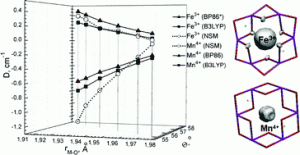
With current oil consumption levels high, light crude oil reserves will be exhausted, giving way to heavy and extra heavy bitumen refinery feeds. These contain a higher proportion of large polycyclic hydrocarbons, together with N- and S-heteroaromatics, which need to be removed or transformed, without catalyst poisoning. Current methods to do this require high temperatures and pressures.
The catalyst made by the researchers, composed of ruthenium nanoparticles immobilised on a polymer, hydrogenates aromatic compounds under moderate conditions with no poisoning.
Hydrogenation of arenes and N-heteroaromatic compounds over ruthenium nanoparticles on poly(4-vinylpyridine): a versatile catalyst operating by a substrate-dependent dual site mechanism
Minfeng Fang, Nataliya Machalaba and Roberto A. Sánchez-Delgado
Dalton Trans., 2011, DOI: 10.1039/C1DT10801H











 Read this Dalton Transactions Hot article to find out about how uranium can reductively couple carbon monoxide, an interesting reaction in Fischer-Tropsch chemistry.
Read this Dalton Transactions Hot article to find out about how uranium can reductively couple carbon monoxide, an interesting reaction in Fischer-Tropsch chemistry. Read Leonard Lindoy’s latest supramolecular host-guest formation research in this Dalton Transactions Hot article.
Read Leonard Lindoy’s latest supramolecular host-guest formation research in this Dalton Transactions Hot article.


 In this Dalton Transactions Hot article Andrew Burrows and Frank Marken and colleagues from the University of Bath make MOFs of zincII and aluminiumIII dicarboxylate frameworks with covalently attached ferrocene functional redox groups.
In this Dalton Transactions Hot article Andrew Burrows and Frank Marken and colleagues from the University of Bath make MOFs of zincII and aluminiumIII dicarboxylate frameworks with covalently attached ferrocene functional redox groups.![Co(III) sarcophagine and p-sulfonated calix[4]arene supermolecules](http://www.rsc.org/ej/DT/2011/c1dt10550g/c1dt10550g-f1.gif) In this Dalton Transactions Hot article Colin Raston and collaborators from the University of Western Australia and the University of Malaya look at CoIII sarcophagine-type cage molecules.
In this Dalton Transactions Hot article Colin Raston and collaborators from the University of Western Australia and the University of Malaya look at CoIII sarcophagine-type cage molecules. This HOT article describes the synthesis and crystal structures of four mono- or bi-cyclic Mo/S/Cu clusters from a pre-designed cluster [(η5-C5Me5)2Mo2(µ3-S)4(CuMeCN)2]2+ with tetraphosphine or N,P mixed ligands. The femtosecond third order non-linear optical (NLO) performances of the products are enhanced due to the increased number of cluster cores. As both the cluster-based building blocks and the multiple organic linkers are pre-designed, it could be useful for the rational design and assembly of coordination frameworks, possibly allowing the preparation of other new materials with enhanced NLO performance.
This HOT article describes the synthesis and crystal structures of four mono- or bi-cyclic Mo/S/Cu clusters from a pre-designed cluster [(η5-C5Me5)2Mo2(µ3-S)4(CuMeCN)2]2+ with tetraphosphine or N,P mixed ligands. The femtosecond third order non-linear optical (NLO) performances of the products are enhanced due to the increased number of cluster cores. As both the cluster-based building blocks and the multiple organic linkers are pre-designed, it could be useful for the rational design and assembly of coordination frameworks, possibly allowing the preparation of other new materials with enhanced NLO performance.